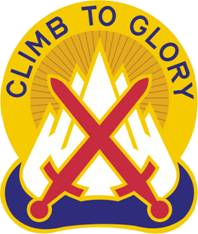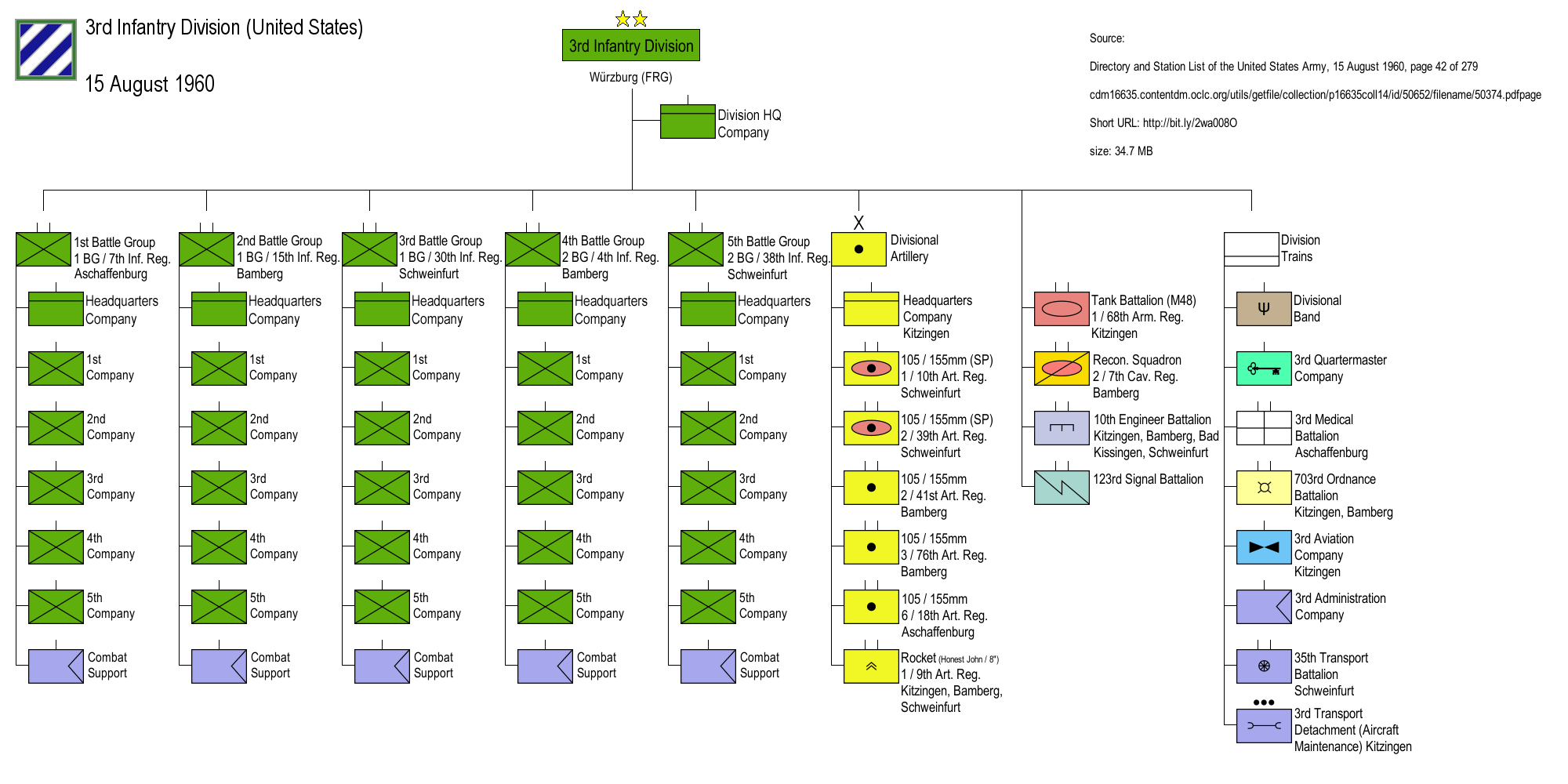|
1-87th Infantry
The 87th Infantry Regiment is an infantry regiment in the United States Army. The regiment's 1st and 2nd Battalions are light infantry units assigned to the 1st and 2nd Brigade Combat Teams respectively of the 10th Mountain Division located at Fort Drum, New York. The 3d Battalion was active in the U.S. Army Reserve in Colorado. The 4th Battalion was a Regular Army unit assigned to the 3rd Brigade Combat Team of the 25th Infantry Division (Light) at Schofield Barracks, Hawaii. History World War II The 87th Mountain Infantry Battalion was activated on 15 November 1941 at Fort Lewis, Washington, with Lieutenant Colonel Onslow S. Rolfe as the commanding officer. This unit was the first American unit of mountain troops. On 12 May 1942, the regiment was reorganized as the 87th Mountain Infantry, with the remainder of the regiment activated there on 25 May 1942. It was expanded into a regiment in the summer of 1942 and moved to Camp Hale, Colorado, where it joined the 10th Mountain ... [...More Info...] [...Related Items...] OR: [Wikipedia] [Google] [Baidu] |
10th Mountain Division (United States)
The 10th Mountain Division (Light Infantry) is a light infantry division in the United States Army based at Fort Drum, New York. Formerly designated as a mountain warfare unit, the division was the only one of its size in the US military to receive specialized training for fighting in mountainous conditions. More recently, the 10th Mountain has been conducting operations in Iraq and Syria advising and assisting Iraqi Security Forces and People's Defense Units. Originally activated as the 10th Light Division (Alpine) in 1943, the division was redesignated the 10th Mountain Division in 1944 and fought in the mountains of Italy in some of the roughest terrain in World War II. On 5 May 1945 the division reached Nauders, Austria, just beyond the Reschen Pass, where it made contact with German forces being pushed south by the U.S. Seventh Army. A status quo was maintained until the enemy headquarters involved had completed their surrender to the Seventh. On 6 May, 10th Mountain troop ... [...More Info...] [...Related Items...] OR: [Wikipedia] [Google] [Baidu] |
Camp Hale
Camp Hale was a U.S. Army training facility in the western United States, constructed in 1942 for what became the 10th Mountain Division. Located in central Colorado between Red Cliff and Leadville in the Eagle River valley, it was named for General Irving Hale and was at an elevation of above sea level. Onslow S. Rolfe, who had developed mountain warfare techniques as commander of the 87th Mountain Infantry Regiment, was selected to command Camp Hale. Soldiers were trained in mountain climbing, Alpine and Nordic skiing, cold-weather survival, as well as various weapons and ordnance. When it was in full operation, approximately 15,000 soldiers were housed there. The creation of an elite ski corps was a national effort, with assistance from the National Association of Ski Patrol, local ski clubs, and Hollywood. Enough men were recruited to create three army regiments, which were deployed after training. Camp Hale was decommissioned in November 1945. On October 12, 2022 ... [...More Info...] [...Related Items...] OR: [Wikipedia] [Google] [Baidu] |
4th Infantry Division (United States)
The 4th Infantry Division is a division of the United States Army based at Fort Carson, Colorado. It is composed of a division headquarters battalion, three brigade combat teams (two Stryker and one armor), a combat aviation brigade, a division sustainment brigade, and a division artillery. The 4th Infantry Division's official nickname, "Ivy", is a play on words of the Roman numeral ''IV'' or 4. Ivy leaves symbolize tenacity and fidelity which is the basis of the division's motto: "Steadfast and Loyal". The second nickname, "Iron Horse", has been adopted to underscore the speed and power of the division and its soldiers. World War I The 4th Division was organized at Camp Greene, North Carolina on 10 December 1917 under the command of Maj. Gen. George H. Cameron. It was here they adopted their distinctive insignia, the four ivy leaves. The ivy leaf came from the Roman numerals for four (IV) and signified their motto "Steadfast and Loyal". The division was organized as p ... [...More Info...] [...Related Items...] OR: [Wikipedia] [Google] [Baidu] |
8th Infantry Regiment (United States)
The 8th Infantry Regiment of the United States, also known as the "Fighting Eagles," is an infantry regiment in the United States Army. The 8th Infantry participated in the Mexican War, American Civil War, Philippine Insurrection, Moro Rebellion, World War I, World War II, Vietnam War, and Iraq Campaign. Coat of arms Blazon #Shield: Argent on a bend azure (heraldry), between (in sinister chief) a tomahawk Gules halved Sable and an arrow of the last barbed of the third in saltire and in dexter base an eagle's claw erased Proper, three roses of the field seeded of the third. #Crest: On a wreath of the colors Argent and Azure out of a mural coronet a dexter arm in armor embowed the hand grasping a flagstaff with tassel all Proper. #Motto: "PATRIAE FIDELITAS" (Loyalty to Country). Symbolism *Shield: #The shield is white with a blue bend, the Infantry colors. #The three heraldic flowers on the bend are symbolic of: first, the Rose, the flower of the state of New York, where ... [...More Info...] [...Related Items...] OR: [Wikipedia] [Google] [Baidu] |
509th Infantry Regiment (United States)
The 509th Infantry Regiment (previously the 509th Parachute Infantry Regiment) is an airborne infantry regiment of the United States Army. The unit was initially activated as a single battalion, the 504th Parachute Infantry Battalion, in October 1941 at Fort Benning, Georgia. Nicknamed "Geronimo", the 509th conducted the U.S. Army's first combat jump during World War II on 8 November 1942, flying 1,500 miles from England to seize Tafarquay airport in Oran, Algeria. The 509th made a total of five combat jumps during the war. The 1st and 3rd Battalions remain active. 1st Battalion serves as the Opposing Force (OPFOR) at the U.S. Army's Joint Readiness Training Center at Fort Polk, Louisiana, while 3rd Battalion is assigned to the 2nd Infantry Brigade Combat Team (Airborne), 11th Airborne Division, at Fort Richardson, Alaska. The 509th operates independently from larger airborne units such as the 82nd Airborne Division. History The advent of World War II ushered in a need fo ... [...More Info...] [...Related Items...] OR: [Wikipedia] [Google] [Baidu] |
Gonsenheim
Gonsenheim is a borough in the northwest corner of Mainz, Germany. With about 25,000 inhabitants, it is the second-most populated borough of Mainz, before Oberstadt and after Neustadt. History Protohistory The history of Gonsenheim reaches back to the Neolithic Era, the Chalcolithic Europe (2800 to 2400 B.C.). Finds of prehistoric people in Gonsenheim can be dated back to the late Neolithic period (2800 BC to 2200 BC). The Beilde pot find in the Gewann Auf dem Kästrich (today: "An der Ochsenwiese") near the Gonsenheim railway station is probably of supra-regional significance for Gonsenheim's prehistory. Here, in 1850, five polished flat Jadeite axes were found in the sand dunes typical of Gonsenheim, which can be assigned to the Late Neolithic period. These axes were of high material value at that time and were probably imported from the Maritime Alps. From the time of the hill grave culture (1600-1300/1200 BC) there are some grave finds from hill graves in Gonsenheim; the set ... [...More Info...] [...Related Items...] OR: [Wikipedia] [Google] [Baidu] |
Pentomic
Pentomic (cf. ''Greek pent(e)-'' +''-tome'' "of five parts") was a structure for infantry and airborne divisions adopted by the US Army between 1957 and 1963, in response to the potential use of tactical nuclear weapons, on future battlefields. It was intended that the five subordinate units, which were often referred to as battle groups (to distinguish them from traditional units), would be able to deploy and engage in operations more rapidly than conventional brigades, whilst also having greater offensive capabilities than conventional battalions. One US Army publication defines the pentomic division as "a public relations term designed to combine the concept of five subordinate units ('penta') with the idea of a division that could function on itheran atomic or nonatomic battlefield". Several other countries also temporarily adopted similar structures in their armed forces, at around the same time as the US example, including France (from 1955), Australia, Turkey and ... [...More Info...] [...Related Items...] OR: [Wikipedia] [Google] [Baidu] |
Fort Riley, Kansas
Fort Riley is a United States Army installation located in North Central Kansas, on the Kansas River, also known as the Kaw, between Junction City and Manhattan. The Fort Riley Military Reservation covers 101,733 acres (41,170 ha) in Geary and Riley counties. The portion of the fort that contains housing development is part of the Fort Riley census-designated place, with a residential population of 7,761 as of the 2010 census. The fort has a daytime population of nearly 25,000. The ZIP Code is 66442. Namesake Fort Riley is named in honor of Major General Bennet C. Riley, who led the first military escort along the Santa Fe Trail. The fort was established in 1853 as a military post to protect the movement of people and trade over the Oregon, California, and Santa Fe trails. In the years after the Civil War, Fort Riley served as a major United States Cavalry post and school for cavalry tactics and practice. The post was a base for skirmishes with Native Americans after ... [...More Info...] [...Related Items...] OR: [Wikipedia] [Google] [Baidu] |
Training Division
This list of United States Army divisions is divided into three eras: 1911–1917, 1917–1941, and 1941–present. These eras represent the major evolutions of United States Army, army division structure (there have been several minor changes during these times). The 1911–1917 era lists divisions raised during the Army's first attempts at modernizing the division, prior to the authorization of permanent divisions, and the 1917–1941 era lists the first permanent divisions, prior to advent of specialized (armored, airborne, etc.) divisions. The 1941–present era lists all of the divisions organized, raised, or authorized since then. As much as possible, divisions are only listed in the eras in which they were first created. Some divisions, such as the 1st Cavalry Division, are listed in multiple eras, as their organizations were drastically changed from one era to the next. Many divisions overlap the years listed in the era categories, mainly due to the slow pace in which they ... [...More Info...] [...Related Items...] OR: [Wikipedia] [Google] [Baidu] |


_2.jpg)



